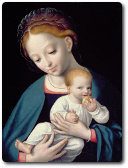Gerard Manley Hopkins, selected poems Contents
Mary as a channel of grace
Honouring Mary
 This theme is the most obviously Catholic subject of them all. Although other Christian churches recognise Mary, the Catholic Church holds her in especial honour and veneration. Certain religious orders give her greater prominence than others in their spirituality, including the Jesuits to whom Hopkins belonged.
This theme is the most obviously Catholic subject of them all. Although other Christian churches recognise Mary, the Catholic Church holds her in especial honour and veneration. Certain religious orders give her greater prominence than others in their spirituality, including the Jesuits to whom Hopkins belonged.
The two most obvious poems which refer to Mary are those Hopkins wrote at Stonygate for its annual day in May devoted to Mary. These are The May Magnificat and The Blessed Virgin. The first is a fairly slight poem, paralleling Spring as the time of birth and motherhood with Mary. There is celebration rather than veneration, with little attempt to make any theological statements.
Mary's grace
In The Blessed Virgin, the parallels or analogies with the air are formed into much more obvious theological statements:
- as the air nurtures humans, so does Mary, not just the baby she is carrying:
‘But mothers each new grace / That does now reach our race'‘Grace' is a difficult concept, especially when it is seen as a countable ‘each grace' rather than just a more abstract entity ‘grace'
- in Mary's ability to bring grace to humans, she is greater than all the pagan goddesses
- she is also able to pray for people:
‘God has let dispense/ Her prayers his providence'. More on the prayers of Mary?More on the prayers of Mary: It should be noted that this idea is one which divides Catholic and Protestant believers; the latter believe only Christ can intercede for them.
In other poems, Mary is only mentioned in passing, for example in Duns Scotus's Oxford. Here the doctrine of her Immaculate Conception is mentioned, something that had only really become official teaching in Hopkins' lifetime. In The Starlight Night, there is the briefest mention of Mary with the other saints as part of the ‘fence' of the church, enclosing the believers.
Recently Viewed
Scan and go
Scan on your mobile for direct link.